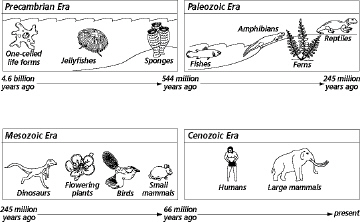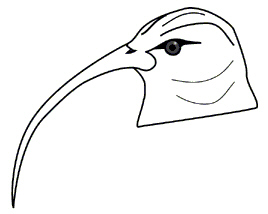Multiple Choice
Identify the
letter of the choice that best completes the statement or answers the question.
|
|
|
1
|
A type of natural selection that favors both of the extremes in a population
is
A | directional selection | C | disruptive selection | B | stabilizing selection | D | artificial
selection |
|
|
|
2
|
Which of the following is the best “definition” of natural
selection?
A | Survival of the biggest | C | Survival of the smartest | B | Survival of the
strongest | D | Surivival of the
genetically fittest |
|
|
|
3
|
If the gene pool of one population is different enough from the gene pool of
another, then they will most likely not be able to
A | evolve over time | C | interbreed and produce fertile offspring | B | undergo natural
selection | D | communicate within
their population |
|
|
|
4
|
The total number of genes in a population is a
A | genetic drift | C | favorable trait | B | gene pool | D | survival of the
fittest |
|
|
|
5
|
The Geologic Time Scale begins at the formation of Earth approximately _____
years ago.
A | 4.6 thousand | C | 46 million | B | 4.6 million | D | 4.6 billion |
|
|
|
6
|
Which fact is the basis for using the fossil record as evidence that evolution
has taken place?
A | In undisturbed layers of rock strata, the older fossils are found in the deeper
layers. | B | There are fossils of all life-forms to be found in rock layers. | C | All fossils were
formed at the same time. | D | Fossils have been shown to provide a complete
record of human evolution. |
|
|
|
7
|
Which of the following fossils are not found in sedimentary rock?
A | imprints | C | amber | B | frozen mammoths | D | petrified wood |
|
|
|
 Figure
14-4
|
|
|
8
|
According to Figure 14-4, in how many eras have mammals existed?
|
|
|
9
|
Hawaiian honeycreepers are a group of birds with similar body shape and size.
However, they vary greatly in color and beak shape. Each species occupies its own niche and is
adapted to the foods available in its niche. The evolution from a common ancestor to a variety of
species is an example of _____.
A | divergent evolution | C | vegetative propagation | B | cross-pollination | D | convergent evolution |
|
|
|
10
|
The flying squirrel of North America closely resembles the flying phalanger of
Australia. They are similar in size and have long, bushy tails and skin folds that allow them to
glide through the air. The squirrel is a placental mammal, while the phalanger is a marsupial. These
close resemblances, even though genetically and geographically separated by great distances, can best
be explained by _____.
A | convergent evolution | C | spontaneous generation | B | divergent
evolution | D | vestigial
structures |
|
|
|
11
|
Within a decade of the introduction of a new insecticide, nearly all of the
descendants of the target pests were immune to the usual-sized dose. The most likely explanation for
this immunity to the insecticide is that _____.
A | eating the insecticide caused the bugs to become resistant to it | B | eating the
insecticide caused the bugs to become less resistant to it | C | it destroyed
organisms that cause disease in the insects, thus allowing them to live longer | D | the pests developed
physiological adaptations to the insecticide |
|
|
|
12
|
Natural processes such as speciation and gradualism provide the genetic basis
for _____.
A | evolution | C | biogenesis | B | spontaneous generation | D | sexual
reproduction |
|
|
|
13
|
A pattern of evolution that results when two unrelated species begin to appear
similar because of environmental conditions is _____.
A | disruptive selection | C | directional selection | B | convergent
evolution | D | divergent
evolution |
|
|
|
14
|
The average individuals of a population are favored in _____ selection.
A | directional | C | disruptive | B | stabilizing | D | natural |
|
|
|
15
|
In _____ selection, individuals with both extreme forms of a trait are at a
selective advantage.
A | directional | C | disruptive | B | stabilizing | D | natural |
|
|
|
16
|
_____ selection favors one extreme form of a trait in a population.
A | Directional | C | Disruptive | B | Stabilizing | D | Natural |
|
|
|
17
|
A mechanism of Darwin's proposed theory is _____.
A | artificial selection | C | variation | B | evolution | D | all of these |
|
|
|
18
|
Why might the beak of the Akialoa, pictured in Figure 15-7, developed this
way?  Figure
15-7 A | to reach nectar in flowers | C | to scoop up fish | B | to dig through tree
bark for insects | D | to crack
open seeds |
|
|
|
19
|
The placing of information or objects into groups based on certain similarities
is _____.
A | biochemical analysis | C | phylogeny | B | classification | D | speciation |
|
|
|
20
|
Biologists use ______________ to create a cladogram.
A | derived traits | C | discretionary | B | behavioral | D | pedigrees |
|
|
|
21
|
Structures that have a similar evolutionary origin and structure but are adapted
for different purposes, such as a bat wing and a human arm, are called _____.
A | embryological structures | C | homologous
structures | B | analogous structures | D | homozygous structures |
|
|
|
22
|
Natural selection can best be defined as the _____.
A | survival of the biggest and strongest organisms in a population | B | elimination of the
smallest organisms by the biggest organisms | C | survival and reproduction of the organisms that
occupy the largest area | D | survival and reproduction of the organisms that
are genetically best adapted to the environment |
|